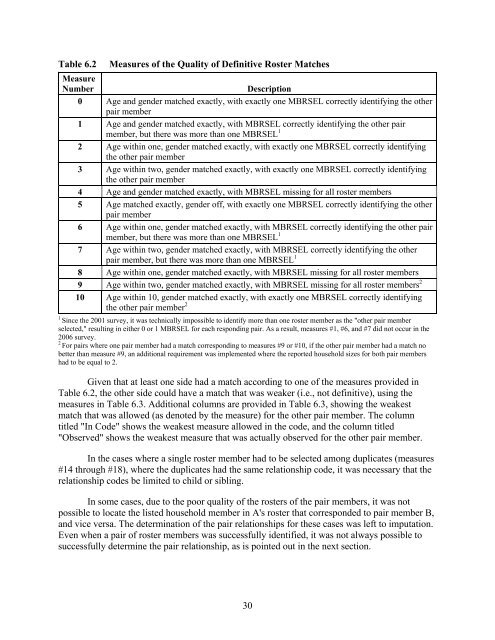Questionnaire Dwelling Unit-Level and Person Pair-Level Sampling ...
Questionnaire Dwelling Unit-Level and Person Pair-Level Sampling ...
Questionnaire Dwelling Unit-Level and Person Pair-Level Sampling ...
You also want an ePaper? Increase the reach of your titles
YUMPU automatically turns print PDFs into web optimized ePapers that Google loves.
Table 6.2<br />
Measures of the Quality of Definitive Roster Matches<br />
Measure<br />
Number<br />
Description<br />
0 Age <strong>and</strong> gender matched exactly, with exactly one MBRSEL correctly identifying the other<br />
pair member<br />
1 Age <strong>and</strong> gender matched exactly, with MBRSEL correctly identifying the other pair<br />
member, but there was more than one MBRSEL 1<br />
2 Age within one, gender matched exactly, with exactly one MBRSEL correctly identifying<br />
the other pair member<br />
3 Age within two, gender matched exactly, with exactly one MBRSEL correctly identifying<br />
the other pair member<br />
4 Age <strong>and</strong> gender matched exactly, with MBRSEL missing for all roster members<br />
5 Age matched exactly, gender off, with exactly one MBRSEL correctly identifying the other<br />
pair member<br />
6 Age within one, gender matched exactly, with MBRSEL correctly identifying the other pair<br />
member, but there was more than one MBRSEL 1<br />
7 Age within two, gender matched exactly, with MBRSEL correctly identifying the other<br />
pair member, but there was more than one MBRSEL 1<br />
8 Age within one, gender matched exactly, with MBRSEL missing for all roster members<br />
9 Age within two, gender matched exactly, with MBRSEL missing for all roster members 2<br />
10 Age within 10, gender matched exactly, with exactly one MBRSEL correctly identifying<br />
the other pair member 2<br />
1<br />
Since the 2001 survey, it was technically impossible to identify more than one roster member as the "other pair member<br />
selected," resulting in either 0 or 1 MBRSEL for each responding pair. As a result, measures #1, #6, <strong>and</strong> #7 did not occur in the<br />
2006 survey.<br />
2<br />
For pairs where one pair member had a match corresponding to measures #9 or #10, if the other pair member had a match no<br />
better than measure #9, an additional requirement was implemented where the reported household sizes for both pair members<br />
had to be equal to 2.<br />
Given that at least one side had a match according to one of the measures provided in<br />
Table 6.2, the other side could have a match that was weaker (i.e., not definitive), using the<br />
measures in Table 6.3. Additional columns are provided in Table 6.3, showing the weakest<br />
match that was allowed (as denoted by the measure) for the other pair member. The column<br />
titled "In Code" shows the weakest measure allowed in the code, <strong>and</strong> the column titled<br />
"Observed" shows the weakest measure that was actually observed for the other pair member.<br />
In the cases where a single roster member had to be selected among duplicates (measures<br />
#14 through #18), where the duplicates had the same relationship code, it was necessary that the<br />
relationship codes be limited to child or sibling.<br />
In some cases, due to the poor quality of the rosters of the pair members, it was not<br />
possible to locate the listed household member in A's roster that corresponded to pair member B,<br />
<strong>and</strong> vice versa. The determination of the pair relationships for these cases was left to imputation.<br />
Even when a pair of roster members was successfully identified, it was not always possible to<br />
successfully determine the pair relationship, as is pointed out in the next section.<br />
30
















